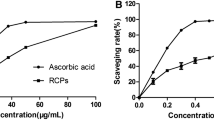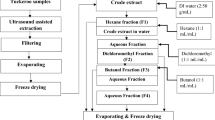Abstract
4′-Geranyloxyferulic (GOFA) and boropinic acid have been discovered during the last decade as interesting phytochemicals having valuable pharmacological effects as cancer chemopreventive, anti-inflammatory, neuroprotective, and anti-Helicobacter pylori agents. A reverse-phase HPLC-UV/Vis method for the separation and quantification of the title oxyprenylated ferulic acid derivatives in extracts obtained from peels of nine edible Citrus and Fortunella fruits was successfully applied. Concentration values showed a great variation between the different species, being orange (C. sinensis) the fruit richest in GOFA (0.141 ± 0.011 mg/g of exocarp fresh weight) and kumquat (Fortunella japonica) the one in which boropinic acid was recorded as the most abundant phytochemical (0.206 ± 0.002 mg/g of exocarp fresh weight). Both secondary metabolites were not detected only in three species. The set-up methodology showed limits of quantification (LOQ) values, that were able to selectively quantify both GOFA and boropinic acid. Results described herein depict a potential chemopreventive dietary feeding role for the Rutaceae spp. under investigation.



Similar content being viewed by others
Abbreviations
- GOFA:
-
4′-Geranyloxyferulic acid
- HPLC:
-
High performance liquid chromatography
- LC:
-
Liquid chromatography
- LOD:
-
Limit of detection
- LOQ:
-
Limit of quantification
- ND:
-
Not detected
- QC:
-
Quality control
- RP:
-
Reverse phase
- RSD:
-
Relative standard deviation
- R.t.:
-
Room temperature
- SD:
-
Standard deviation
- S/N:
-
Signal to noise
- Spp.:
-
Species
- UV:
-
Ultraviolet
- Vis:
-
Visible
References
Magiorkinis E, Beloukas A, Diamantis A (2011) Scurvy: past, present and future. Eur J Intern Med 22:147–152
Pak CY (2004) Medical management of urinary stone disease. Nephron Clin Prac 98:c49–c53
Sica DA (2006) Interaction of grapefruit juice and calcium channel blockers. Am J Hypertens 19:768–773
Cha JY, Cho YS, Kim I, Anno T, Rahman SM, Yanagita T (2001) Effect of hesperetin, a citrus flavonoid, on the liver triacylglycerol content and phosphatidate phosphohydrolase activity in orotic acid-fed rats. Plant Foods Hum Nutr 56:349–358
Assis Coelho RCL, Hermsdorff HHM, Bressan J (2013) Anti-inflammatory properties of orange juice: possible favorable molecular and metabolic effects. Plant Foods Hum Nutr 68:1–10
Sadek ES, Makris DP, Kefalas P (2009) Polyphenolic composition and antioxidant characteristics of kumquat (Fortunella margarita) peel fractions. Plant Foods Hum Nutr 64:297–302
Alvarez-Gonzales I, Madrigal-Bujaidar E, Sanchez-Garcia VY (2010) Inhibitory effect of grapefruit juice on the genotoxic damage induced by ifosfamide in mouse. Plant Foods Hum Nutr 65:369–373
Rein MJ, Renouf M, Cruz-Hernandez C, Actis-Goretta L (2013) Thakkar SK, da Silva Pinto M (2013) Bioavailability of bioactive food compounds: a challenging journey to bioefficacy. Br J Clin Pharmacol 75:588–602
González-Molina E, Domínguez-Perles R, Moreno DA, García-Viguera C (2010) Natural bioactive compounds of Citrus limon for food and health. J Pharm Biomed Anal 51:327–345
Gullett NP, Ruhul Amin AR, Bayraktar S, Pezzuto JM, Shin DM, Khuri FR, Aggarwal BB, Surh YJ, Kucuk O (2010) Cancer prevention with natural compounds. Semin Oncol 37:258–281
Hwang SL, Shih PH, Yen GC (2012) Neuroprotective effects of Citrus flavonoids. J Agric Food Chem 60:877–885
Chanet A, Milenkovic D, Manach C, Mazur A, Morand C (2012) Citrus flavanones: what is their role in cardiovascular protection? J Agric Food Chem 60:8809–8822
Assini JM, Mulvihill EE, Huff MW (2013) Citrus flavonoids and lipid metabolism. Curr Opin Lipidol 24:34–40
Munakata R, Inoue T, Koeduka T, Sasaki K, Tsurumaru Y, Sugiyama A, Uto Y, Hori H, Azuma J, Yazaki K (2012) Characterization of coumarin-specific prenyltransferase activities in Citrus limon peel. Biosci Biotechnol Biochem 76:1389–1393
Curini M, Cravotto G, Epifano F, Giannone G (2006) Chemistry and biological activity of natural and synthetic prenyloxycoumarins. Curr Med Chem 2:199–222
Epifano F, Genovese S, Menghini L, Curini M (2007) Chemistry and pharmacology of oxyprenilated secondary plant metabolites. Phytochemistry 68:939–953
Epifano F, Genovese S (2013) Recent acquisitions on naturally occurring oxyprenylated secondary plant metabolites. In: Brahmachari G (ed) Chemistry and pharmacology of naturally occurring bioactive compounds, 1st edn. CRC Press, Boca Raton, pp 239–257
Prager RH, Thregold HM (1966) Some neutral constituents of Acronychia baueri. Aust J Chem 3:451–454
Genovese S, Curini M, Gresele P, Corazzi T, Epifano F (2011) Inhibition of COX-1 activity and COX-2 expression by 3-(4′-geranyloxy-3′-methoxyphenyl)-2-trans propenoic acid and its semi-synthetic derivatives. Bioorg Med Chem Lett 21:5995–5998
Epifano F, Molinaro G, Genovese S, Teke Ngomba R, Nicoletti F, Curini M (2008) Neuroprotective effect of prenyloxycoumarins from edible vegetables. Neurosci Lett 443:57–60
Miyamoto S, Epifano F, Curini M, Genovese S, Kimi M, Ishigamori-Suzuki R, Yasui Y, Sugie S, Tanaka T (2008) A novel prodrug of 4′-geranyloxyferulic acid suppresses colitis-related colon carcinogenesis in mice. Nutr Canc 5:675–684
Genovese S, Epifano F (2012) Recent developments in the pharmacological properties of 4′-geranyloxyferulic acid, a colon cancer chemopreventive agent of natural origin. Curr Drug Targets 13:1083–1088
Ito C, Itoigawa M, Otsuka T, Takuda H, Nishino H, Furukawa H (2000) Constituents of Boronia pinnata. J Nat Prod 63:1344–1348
Touati E, Michel V, Correia M, Menghini L, Genovese S, Curini M, Epifano F (2009) Boropinic acid, a novel inhibitor of Helicobacter pylori stomach colonization. J Antimicrob Chemother 64:210–211
Epifano F, Sosa S, Tubaro A, Marcotullio MC, Curini M, Genovese S (2011) Topical anti-inflammatory activity of boropinic acid and its semi-synthetic derivatives. Bioorg Med Chem Lett 21:769–772
Curini M, Genovese S, Menghini L, Marcotullio MC, Epifano F (2008) Phytochemistry and pharmacology of Boronia pinnata Sm. Nat Prod Commun 3:2145–2150
Genovese S, Epifano F, Carlucci G, Fiorito S, Locatelli M (2014) HPLC analysis of 4′-geranyloxyferulic and boropinic acids in grapefruits of different geographical origin. Phytochem Lett 8:190–192
Genovese S, Epifano F, Carlucci G, Marcotullio MC, Curini M, Locatelli M (2010) Quantification of 4′-geranyloxyferulic acid, a new natural colon cancer chemopreventive agent, by HPLC-DAD in grapefruit skin extract. J Pharm Biomed Anal 53:212–214
Gosslau A, Li S, Ho CT, Chen KY, Rawson NE (2011) The importance of natural product characterization in studies of their anti-inflammatory activity. Mol Nutr Food Res 55:74–82
Moraes TM, Rozza AL, Kushima H, Pellizzon CH, Rocha LR, Hiruma-Lima CA (2013) Actions of essential oils from Citrus aurantium and d-limonene in the gastric mucosa: the roles of VEGF, PCNA, and COX-2 in cell proliferation. J Med Food 13:1162–1167
Hedrick VE, Dietrich AM, Estabrooks PA, Savla J, Serrano E, Davy BM (2012) Dietary biomarkers: advances, limitations and future directions. Nutr J. doi:10.1186/1475-2891-11-109
De Rosa S, De Giulio A, Iodice C (1994) Biological effects of prenylated hydroquinones: structure-activity relationship studies in antimicrobial, brine shrimp, and fish lethality assays. J Nat Prod 57:1711–1716
Meiyanto E, Hermawan A, Anindyajati (2013) Natural products for cancer-targeted therapy: citrus flavonoids as potent chemopreventive agents. Asian Pac J Cancer Prev 13:427–436
Tanaka T, Tanaka T, Tanaka M, Kuno T (2012) Cancer chemoprevention by citrus pulp and juices containing high amounts of β-cryptoxanthin and hesperidin. J Biomed Biotechnol. doi:10.1155/2012/516981
Aggarwal BB, Shishodia S (2006) Molecular targets of dietary agents for prevention and therapy of cancer. Biochem Pharmacol 71:1397–1421
Acknowledgments
Financial support to this research from the University “G. D’Annunzio” of Chieti-Pescara was gratefully acknowledged. Authors wish to thank Angela Cammisa and Paolo Di Vincenzo for their friendly and active collaboration to this work.
Conflict of Interest
All authors confirmed that they have no conflict of interest.
Studies with Humans or Animals
This article does not contain any studies with human or animal subjects.
Author information
Authors and Affiliations
Corresponding author
Rights and permissions
About this article
Cite this article
Genovese, S., Fiorito, S., Locatelli, M. et al. Analysis of Biologically Active Oxyprenylated Ferulic Acid Derivatives in Citrus Fruits. Plant Foods Hum Nutr 69, 255–260 (2014). https://doi.org/10.1007/s11130-014-0427-8
Published:
Issue Date:
DOI: https://doi.org/10.1007/s11130-014-0427-8




